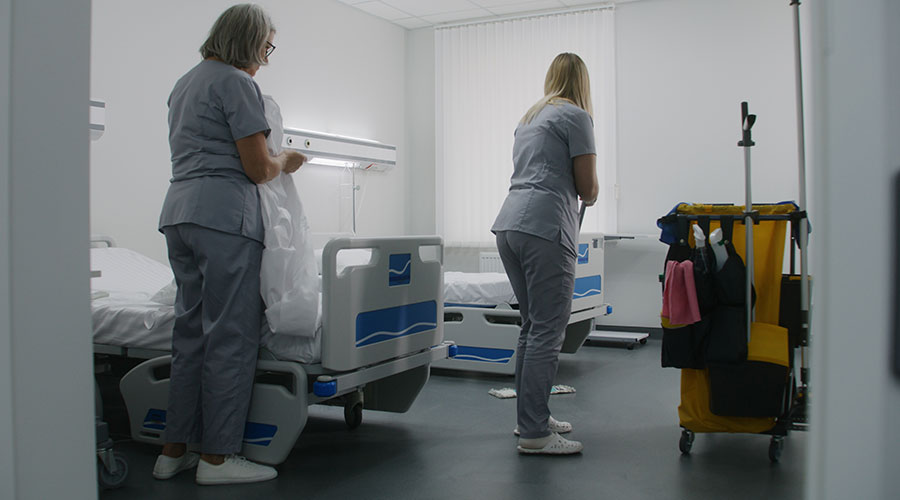The state of healthcare is ever changing and becoming a more competitive market. Hospitals continue to face regulatory challenges (i.e., federal, state, employee satisfaction surveys, HCCAPS, MSDS, OSHA), insurance premium rate hikes, new and polymorphic diseases and census swings.
In addition, drastic changes are occurring while Medicaid and Medicare reduce reimbursements and not-for-profit health systems continue to absorb greater debt as the uninsured undergo clinical treatments.
The trend toward “mega-systems” continues to increase as more and more hospitals are leaving their independent status behind to join a system or network. According to the American Hospital Association, in 2001, approximately half of all hospitals (excluding government and public facilities) were independent.
By 2012, 62% were affiliated with a system. And by 2013, even though the number of transactions in the U.S. declined, the number of hospitals and hospital beds involved in these transactions hit a five-year high, according to Irving Levin Associates 2014 Health Care Services Acquisition Report.
Emergence of new healthcare market threats
While competition has always existed from neighboring hospitals, an additional threat has entered the market. Local and national pharmacies, such as Wal-Mart and CVS, are beginning to pull from the existing patient base.
This dilution, coupled with federal/state regulations and reductions in reimbursement, can negatively impact hospital revenues. With all of these pressures, not to mention the need to update aging facilities and expand the existing footprint, how does a hospital compete in this new economy?
Establishing a recognizable brand
Hospitals have traditionally lagged behind other industries in the pursuit of brand recognition and concentration on the patient experience. Providing exceptional patient care and clinical outcomes has been at the forefront in achieving excellence. Only within the past few years, has the focus shifted toward improving the patient experience and understanding the significance of brand equity. Maybe there is a lot we could learn from the retail industry as it relates to branding.
The value of brand recognition
Think about your experience every time you enter a Starbucks. From the exterior signage and store appearance to the products available for purchase, each and every store is the same (or pretty darn close). Starbucks has invested millions (and probably billions) into creating their brand and thus it is communicated through advertising and promotion, store signage, furniture and fixtures, and even in employee behavior. Everything speaks to the Starbuck’s brand.
But, can we say the same for hospitals or facilities within a system? If we have reached a point where most hospitals are part of a larger system, shouldn’t we be able to expect this same type of consistency and comfort when we move from one facility to the next within a network?
Granted, not everyone visits a hospital as often as they visit a Starbuck, unless of course they are being treated for a chronic illness, but wouldn’t it be comforting to enter a facility and immediately be familiar with your surroundings. Shouldn’t that facility speak to the brand of the network or system?
But, things are changing. According to new research by The Beryl Institute, the patient experience is one of the top three priorities of hospital leaders over the next three years. So what can a hospital do to build a consistent brand and improve the patient experience, all while trying to reduce costs?
Road to improvement
Over the last ten (10) years, major hospitals, architects, general contractors, interior designers and equipment transition firms have pulled healthcare, hospitality aesthetics and concierge into their facility master plans. Modeling solutions have moved from the hospital core lobby or atrium to food/cafeteria and even patient rooms also known as “VIP Rooms”.
Up-scaled patient rooms, providing less invasive environments, have tremendous appeal not only to the patient but also to the family. In addition, healing roof systems (i.e., vegetative roof systems or gardening areas) inclusive of water fountains have been implemented to create a healthier environment and to meet the ever changing specification standards.
As non-acute and outpatient facilities (i.e. off campus ambulatory, surgery, physician clinics, wellness sites, daycares, extended and long-term living facilities, etc.) are added to system portfolios, replicating modeling solutions and retail practices from center to center will aid in driving out waste and reducing cost.
Creating consistency while capitalizing on economies of scale should be a core proponent of a system’s strategy. Identifying solutions that assist in delivering a uniform brand while challenging suppliers to create new visual and budgetary business models will produce a competitive advantage and best-in-class outcomes.
Maintaining a patient focus
So how does an organization identify these opportunities while maintaining a laser focus on its core strength – patient care? Outsourcing of services and strategic sourcing are two options. Outsourcing enables clients to access current FF&E; mechanical, electrical, plumbing (MEP); janitorial cleanliness; and landscaping beautification standardization needs through various platform experts (e.g. Construction, Facilities Management, Real Estate and Energy).
These platform experts can assist in identifying new market innovations that can be incorporated across the system to solidify the brand. Strategic Sourcing is then utilized to produce savings and efficiencies by aggregating purchasing volume and using that leverage to negotiate discounts with specific suppliers.
Leveraging outsourcing and strategic sourcing in unison can provide significant cost reductions and ensure uniformity and consistency across the system.
Conclusion
As healthcare systems continue to expand, they must begin to evaluate their entire portfolio of facilities when developing their branding strategy. Creating standards that can be replicated from location to location will deliver the outcomes that enhance the patient experience.
Leveraging the expertise and knowledge available through outsourcing and strategic sourcing will eliminate waste and reduce cost while promoting the brand and allowing hospital leadership to keep their eye on delivering superior patient care.
Stephen Sawyer is the director of strategic sourcing for CBRE Healthcare.

 Disinfectant Dispensers in Healthcare Facilities Often Fail to Deliver Safe Concentrations: Study
Disinfectant Dispensers in Healthcare Facilities Often Fail to Deliver Safe Concentrations: Study Duke University Health System Receives $50 Million for Proton Beam Therapy Center
Duke University Health System Receives $50 Million for Proton Beam Therapy Center UT Southwestern Experiences Data Breach Through Calendar Tool
UT Southwestern Experiences Data Breach Through Calendar Tool Protecting Patient Data: Strategies and Tactics
Protecting Patient Data: Strategies and Tactics Duke Health to Acquire Lake Norman Regional Medical Center
Duke Health to Acquire Lake Norman Regional Medical Center